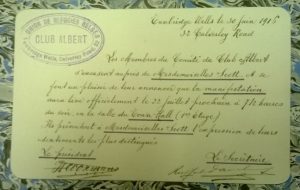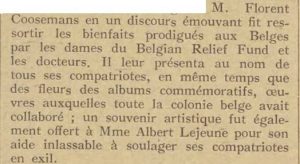
Invitation to the Misses SCOTT for the event on 22 July 1916
(Photograph ©Alison MacKenzie 2013)
On 22nd July 1916, the Belgian Colony of Tunbridge Wells celebrated their National Day (21st July) by honouring the ladies of the Mayor’s Refugee Committee – Mrs BURTON, Mrs GUTHRIE, Miss POWER, Mrs Le LACHEUR, Mme Le JEUNE, Miss McCLEAN, Mrs WILSON and the Misses SCOTT – and the local Doctors – WILSON, C. SMITH and GUTHRIE – who had ministered to the refugees free of charge.
A ceremony and celebration was held in the Town Hall on Calverley Road to which townspeople and Belgian refugees were invited. On the evening in question the hall was packed.
At 7.30pm precisely the Mayor, Councillor Charles Whitbourn EMSON with his wife, Margaret, and Miss EMSON arrived in the hall and were welcomed by Monsieur Florent COOSEMANS, Mrs EMSON then being presented with a floral arrangement of orchids and roses by one of the Belgian children. Monsieur Albert LE JEUNE, Honorary President of the ‘Club Albert’ spoke patriotically of his country’s history and its links with Britain, and Monsieur COOSEMANS then spoke of the two years they had spent in exile and of the kindness afforded to them by the people of Tunbridge Wells, and by the ladies and doctors of the Committee in particular:
The reception received in this lovely county, rightly named the Garden of England, was above what the Belgian people could have expected… It took all the dexterity and amiability of the British, whose noble and chivalrous character was proverbial, to sweeten their troubles and suffering. (Kent & Sussex Courier, 28 July 1916)
Mayor EMSON and Doctor WILSON thanked the gathering on behalf of the Committee and the doctors, and the evening concluded with a concert and the National Anthems of Belgium and Britain.
While the Kent and Sussex Courier reported that a commemorative album to which all the Belgians in the area had contributed, was then presented to Mrs EMSON as the representative of the ladies of the Committee, the Belgian press-in-exile reported that albums were given to each of the ladies of the Committee – including Belgian refugee Mme LE JEUNE – , along with bouquets of flowers.

Extract from La Metropole newspaper (27th July 1916)
What we know for certain is that an album was presented to the Misses SCOTT -Amelia and Louisa. And that is because it still exists – in the Papers of Amelia Scott which are held in the Women’s Library @ LSE .
It is an amazing resource, providing as it does a list of names of possibly all, maybe most, certainly some, of those in the area at the time. Some entries take up a whole page. Other pages are covered with the signatures of several families. There are patriotic poems, poems of gratitude, drawings and paintings.

The Misses Scotts’ Album (Photo ©Alison MacKenzie 2013)
This album is the starting point for this community research Project. A database of all the names has been created by one of our volunteers, Jan Wright, and analysis of the 170 names inscribed therein will provide a snapshot of the Belgian Community in Tunbridge Wells in July 1916.

‘Club Albert’ Committee 1916 (Photo © Alison MacKenzie 2013)
And some fascinating discoveries are being made as we research the names.
Albert LE JEUNE, Hon. President of the Club Albert of Tunbridge Wells, went on to be a Belgian Senator for the Antwerp region. At the end of the war, he sent £50 back to Tunbridge Wells to be used for “educational purposes” It funded historical essay prizes – known as the Le Jeune History Prize – at Skinners School and the County School for Girls (now TWGGS) for many years. Albert Le Jeune’s wife Gabrielle was a member of the Mayor’s Belgian Refugee Committee.
Josef DENYN was the famous ‘carilloneur’ of Malines, who was a close friend of local musician, composer and campanologist, William Wooding STARMER, and spent the whole period of the war in Tunbridge Wells with his family.

Carillon Music by ‘Mechlin Bellmaster’ Josef DENYN
(Photograph © Alison MacKenzie 2013)
Members of the family of painter James ENSOR of Ostend were here – his divorced sister Mariette (known as Mietje or Mitche), her daughter Alex and son-in-law, and their son; and also the artist’s companion and muse, Augusta BOOGAERTS, with her nephew, Pierre GOVAERTS.

Augusta BOOGAERTS and Madame ENSOR
(Photograph ©Alison MacKenzie 2013)
Committee member Georges CANTILLON was a medically-discharged Belgian soldier who had been awarded the Order of Leopold II for bravery on two occasions, in August and October 1914. He was an artist, employed as a painter on glass in civilian life, and while in Tunbridge Wells he was employed as an artist by W.T. Waters, wood letter manufacturer, of 39 Culverden Avenue and Tunnel Road. I wonder whether any of his work still exists? His contribution to the album was a beautifully-illustrated message of gratitude on behalf of all the Belgian soldiers convalescing in the town.

(Photograph ©Alison MacKenzie 2013)
Adapted from an article by Alison MacKenzie on her blog www.belgiansrtw.wordpress.com
Sources :
- Papers of Amelia Scott held at The Women’s Library @ LSE
- Kent and Sussex Courier (British Newspaper Archive)
- be (digital collection of Belgian newspapers)
